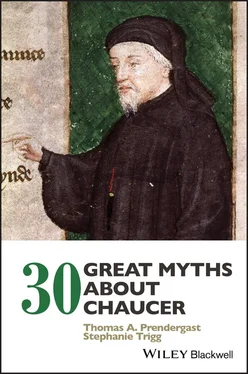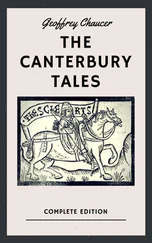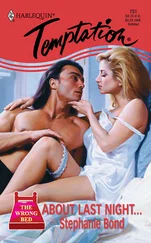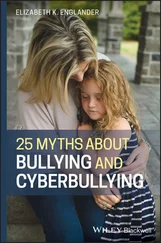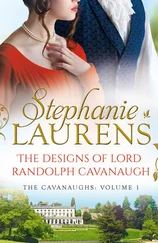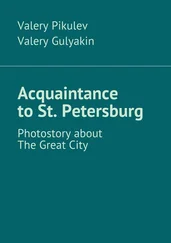4 4F.J. Furnivall, “Thomas Chaucer, Not the Poet Geoffrey’s Son,” Notes and Queries, 4th Series 9 (1872), 381–3, here 381.
5 5Mary Elizabeth Haweis, “More News of Chaucer, Part I,” Belgravia: A London Magazine 48 (1882), 34–46, here 43.
6 6Especially as she references the Glover pedigree contained in Speght’s edition.
7 7Mary Flowers Braswell, The Forgotten Chaucer Scholarship of Mary Eliza Haweis (New York: Routledge, 2016), 17.
8 8Russell Krauss , Haldeen Braddy and C. Robert Kase , Three Chaucer Studies (New York: Oxford University Press, 1932).
9 9Ibid., 169.
10 10Martin M. Crow and Clair C. Olson , eds., Chaucer Life‐Records (Oxford: Oxford University Press, 1966), 80, 85, 88–91.
11 11Martin B. Ruud , Thomas Chaucer (Minneapolis, MN: University of Minnesota Press, 1926), 4–67; Krauss, Braddy and Kase, Three Chaucer Studies, 161.
12 12Peter Ackroyd, Chaucer, Brief Lives (London: Chatto & Windus, 2004), 28.
13 13Crow and Olson, Chaucer Life‐Records, 272.
14 14Ibid., 273.
15 15Alison Weir , Mistress of the Monarchy: The Life of Katherine Swynford, Duchess of Lancaster (New York: Ballantine Books, 2009), 94, 332.
16 16Krauss, Braddy and Kase, Three Chaucer Studies, 143. Furnivall goes even further, claiming that the scribe who copied the poem (John Shirley) would have been sure to mention Thomas’s connection to Geoffrey if there had been one (“Thomas Chaucer,” 381).
17 17Jacquelyn Fernholz and Jenni Nuttall, “Lydgate’s Poem to Thomas Chaucer: A Reassessment of Its Diplomatic and Literary Contexts,” in Identity and Insurgency in the Late Middle Ages, ed. Linda Clark, The Fifteenth Century 6 (Woodbridge: Boydell Press, 2006), 123–44, here 132.
18 18Crow and Olson, Chaucer Life‐Records, 341.
19 19Quoted in Míc&c.dotab;eál Vaughan , “Personal Politics and Thomas Gascoigne’s Account of Chaucer’s Death,” Medium Aevum 75 (2006), 103–22 , here 115. See Myth 27.
20 20Ibid., 109.
21 21H. Ansgar Kelly , “Shades of Incest and Cuckoldry: Pandarus and John of Gaunt,” Studies in the Age of Chaucer 13 (1991), 121–40 , here 137.
22 22Ibid, 137.
23 23See, for instance, Sheila Delany , Writing Woman: Women Writers and Women in Literature Medieval to Modern (New York: Schoken Books, 1983), 58; John H . Fisher, The Importance of Chaucer (Carbondale, IL: Southern Illinois Press, 1992), 19–23; R. Allen Shoaf , Chaucer’s Body: The Anxiety of Circulation in the Canterbury Tales (Gainesville, FL: University of Florida Press, 2001), 100–1; and its persistence as a recurring theme in contemporary historical fiction featuring Chaucer, for example Garry O’Connor , Chaucer’s Triumph (Lancaster: Petrak Press, 2007).
Myth 6
CHAUCER’S LANGUAGE IS TOO DIFFICULT FOR MODERN READERS
Evidence that Chaucer’s language was perceived as difficult appears quite early. Thomas Speght’s 1598 edition of Chaucer, for instance, contains a glossary entitled “the old and obscure words of Chaucer explaned.” At least two translations of Chaucer’s works into modern English were attempted in the early seventeenth century (though only in manuscript), and in 1668 the poet/politician Edmund Waller claimed about the poet that the “years have defac’d his matchless strain.” 1 Things had gotten so bad some twenty‐five years later that the poet and essayist Joseph Addison maintained: “But age has rusted what the poet writ, / Worn out his language, and obscur’d his wit; / In vain he jests in his unpolish’d strain / And tries to make his readers laugh in vain.” 2 It was perhaps to be expected that admirers of Chaucer would attempt to remedy this situation by publishing versions of the poet’s work that would be accessible to the larger reading public.
Most famously, the poet John Dryden undertook to translate three of Chaucer’s tales (and another work that he thought was by the poet) in his Fables, Ancient and Modern . Dryden acknowledges that some readers prefer to read Chaucer in the original and that to translate the poet is to sully his poetry. His response to these naysayers encapsulates the ongoing argument for translation: “Yet I think I have just Occasion to complain of them [those who can read Chaucer in the original], who because they understand Chaucer, would deprive the greater part of their Countrymen of the same Advantage, and hoord him up, as Misers do their Grandam Gold, only to look on it themselves, and hinder others from making use of it.” 3 Chaucer’s poetry, so Dryden argues, should not be the province of the learned few, but belonged to all those who made England their home.
The central question about translation – whether it is possible to capture the effect of the original – really depends on another question that Dryden elides: Is Chaucer’s Middle English readable in the present moment? One might think that if Dryden thought it had to be translated in 1700, then it must be illegible in the twenty‐first century. Even though we are a lot closer to the English of Dryden than Dryden was to the English of Chaucer, as in the eighteenth century, there is a widespread perception that Chaucer’s language is too difficult to read without specialist training. And of course – as we show many times in this book – such myths are often self‐perpetuating. The more Chaucer is perceived as needing expertise and training to make sense of his language, the more reluctant will non‐specialists be to teach Chaucer; while the less he is taught, the more unfamiliar he becomes, and the more obscure become the skills needed to read him. None of this linguistic uncertainty has any bearing on the generally held idea that Chaucer is an important literary figure, but it does affect whether, and how, Chaucer is, or should be, taught in secondary schools, colleges and universities.
Chaucer scholars participate in a further form of contradiction in relation to Chaucer’s perceived difficulty. When they want to argue that Chaucer’s poetry should be included in every mainstream English syllabus they minimize the linguistic difficulties of reading Middle English, but once they are in the classroom they work hard to correct students’ pronunciation, teach vocabulary and medieval syntax, and draw attention to other Middle English dialects.
There are certainly some learnable and teachable skills that can make the experience of reading Chaucer easier and more enjoyable for students familiar with the conventions of English poetry. Teaching Chaucer to students for whom English is a second language, or for whom “standard English” bears little relation to their own dialect or spoken English, is a different challenge altogether. When we ask about Chaucer’s “readability” we should also consider the wide range of contexts in which Chaucer might or might not be taught, from secondary schools through to a broad variety of college and university settings, whether in the UK, or in post‐colonial contexts, or in countries where English is increasingly unlikely to be a student’s first language.
Leaving aside for a moment the question of the “real” linguistic differences between Middle and modern English, let us pause to consider some of the cultural and ideological patterns that construct Chaucer as “difficult.” For one thing, poetry itself is increasingly not taught in some school contexts, so students might equally struggle with the highly metaphorical structures of Shakespeare’s language, and the effects of rhyming and stanzaic patterns on everyday syntax. And second, the Middle Ages are conventionally presented through the cultural and ideological lenses of the deep alterity that renders all of the period’s works both culturally alien and difficult to read. Again and again, we read the phrases “medieval” and “Middle Ages” as code for contexts and languages that are irrelevant, outmoded or archaic.
Читать дальше
